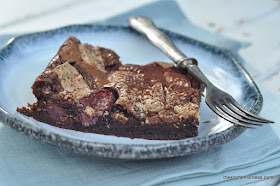To me the Now feels like a really good time to start out with a new outlook on things. To get in the kitchen or boost your outdoor grilling season with fresh, healthy ingredients that although they have a strong character and are delicious when they stand alone, are even more delightful when placed together in an extraordinary summer dish. A meal that is without equal.
We can all keep cooking this summer relying on those well-known, much-beloved, tried and true recipes or we can turn our minds and hearts to new challenges ahead of us. As much as I love those family favorites that are guaranteed to please them all (at least at our house and around our table) – I love to see the look on everyone´s faces when they discover new tastes and different, interesting flavor combinations, perhaps some they have never tasted before.
Trying out new ideas is exciting to all of us and discovering new ingredients is always great fun. But discovering new and different ways to cook with ingredients that are already familiar to us, is, however, possibly even more fun. Take this salad recipe, for instance. You will find yourself happily grating raw cauliflower into crumbs and discover that the little white bits are crunchy and fresh and work well in all manner of raw salads, salsas and other dishes. You might then consider mixing grated cauliflower with other chopped raw vegetables such as carrots or even beetroots or dress them with a tangy vinaigrette and dot with some local goat's cheese. Or, as is done in this recipe, mix-up the freshly grated cauliflower with oven-roasted, caramelized cauliflower florets, for an entirely new taste experience.
I have always loved roast cauliflower, and I have cooked many a dish using cauliflower. There was Stir-fried Sesame Cauliflower (you can take a look here) or Cheat´s Cauliflower Cheese (here) to name but a few but I have not really been known to rave about how tasty it is grated raw, so imagine how delighted I was to discover that the combination of the oven-roasted with the freshly grated cauliflower works spectacularly well.
What better place to look for a recipe today than amongst those creations from the endlessly talented, much-admired and tireless Yotam Ottlenghi who is working and creating and cooking in London, England…
When researching, the first recipe that caught my attention before I prepared Yotam Ottolenghi´s Cauliflower, Pomegranate and Pistachio Salad, was his delightful recipe for Roasted whole Cauliflower with Crème Fraîche. Now that is a looker. Once you have removed the beautifully roasted whole cauliflower from the oven, you then serve it with a lemony crème fraîche and a little extra sea salt (my favorite being Maldon sea salt here with its distinct crystals) for sprinkling on top or alongside.
Cauliflower, Pomegranate and Pistachio Salad
(recipe inspired by Yotam Ottolenghi)
Ingredients
- 60ml sunflower oil
- 1 white onion, (M), peeled and sliced thin
- 1 cauliflower, (L) leaves removed and base trimmed
- 60ml mild olive oil
- sea salt
- 25g Italian parsley leaves, chopped
- 10g mint leaves, roughly chopped
- 7g tarragon leaves, finely chopped
- seeds from ½ medium pomegranate (about 80g net weight)
- 35g unsalted pistachios, toasted and lightly crushed
- ¾ tsp ground cumin
- 1 tbsp freshly squeezed lemon juice
Preparation
- Heat the oven to 190°C (375°F).
- Put the sunflower oil in a small sauté pan over a medium-high heat. Add the onion and cook for eight to 10 minutes, until golden-brown and starting to crisp. Remove from the heat and set aside to cool.
- Coarsely grate a third of the cauliflower (about 160g-worth) and set aside in a large bowl. NOTE: to do this hold the cauliflower by its base and roughly grate the florets on the largest holes of a cheese grater, you should end up with 160g of cauliflower resembling cooked bulgur wheat. The stalks can be discarded or used in crudités.
- Break the remaining cauliflower into medium-sized florets about 3cm wide at the top. Toss the florets in half the olive oil and a quarter-teaspoon of salt, then spread out on a baking sheet.
- Roast for 20 minutes, until cooked through and a dark golden-brown. Remove and set aside to cool.
- Add the onions and their oil to the grated cauliflower, then stir in the remaining olive oil and a quarter-teaspoon of salt.
- Add the remaining ingredients apart from the roast florets, mix well, then gently fold in the florets and serve at once.
And, yes, Germans are known to love, love their cauliflower dishes. But times are changing. And to me it is not enough to rely only on known recipes such as the rather bland Boiled Cauliflower with Butter and Table Salt that I ate when I was a child. Do not get me wrong. This was a dish that was alright at the time but that is not satisfactory anymore. And we all know that. We all know that we can do so much more when we take a fresh and unbiased look at everything and everyone around us. So, be bold. Get out there and get those familiar ingredients but give them a fresh, colorful and healthy make-over that might surprise you, your family, friends and guests in more ways than you ever imagined.
And, yes, the pomegranate´s colorful and bold red seeds add juicy bursts of natural sweetness to this salad, and yes, the bright green, somewhat wonderfully sweet pistachios bring crunch to it and yes, the many different herbs add a delicious fresh flavor here…but more importantly, the flavors come together amazingly well in this delightful, unique and healthy summer dish.
Try it, you might like it.
To me, the Now is begging for new perspectives…



























